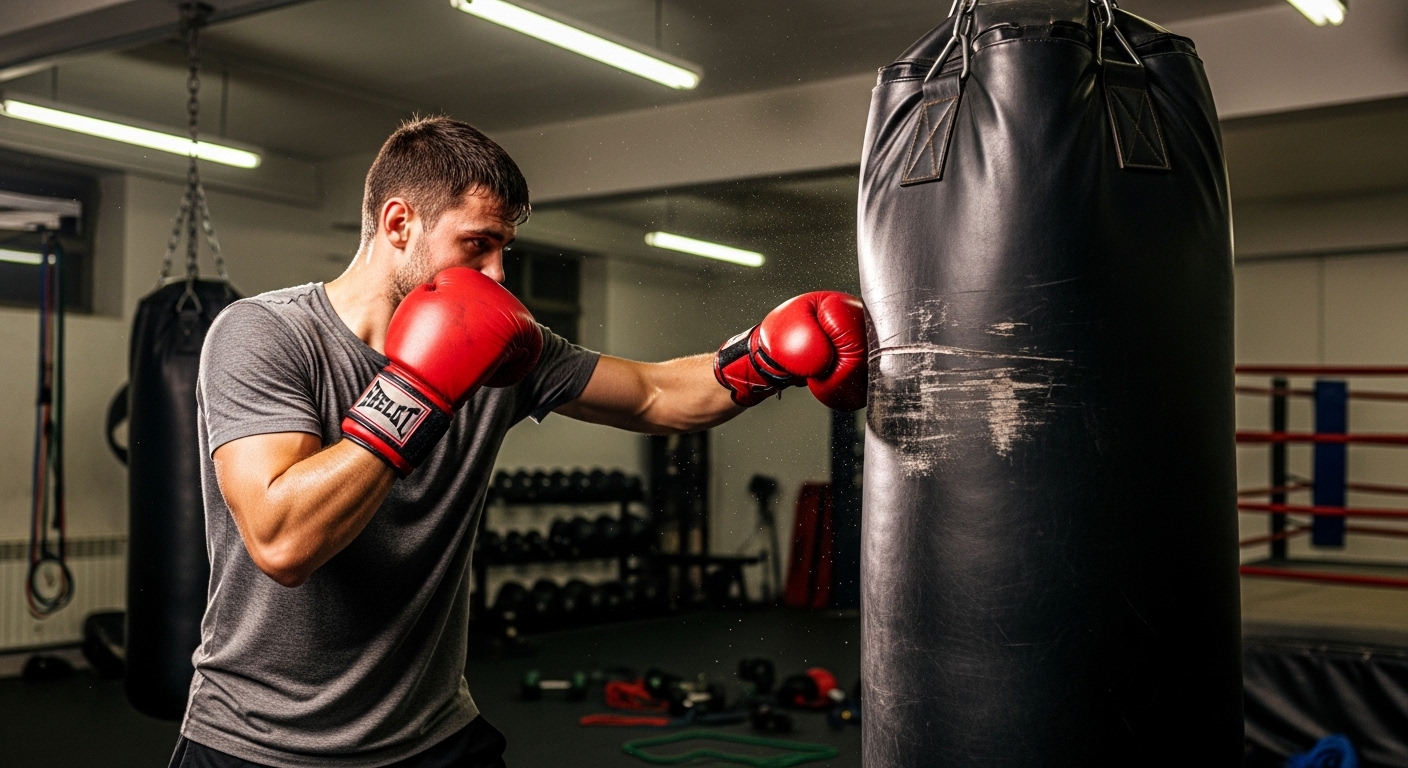Are you ready to unleash your inner fighter and take your fitness to the next level? Can a heavy bag workout really transform your body and improve your technique? Yes, it can! As a beginner, you’re about to start a journey. This journey will boost your boxing technique, increase your power, and enhance your fitness.
Welcome to the world of heavy bag boxing workouts! In this guide, we’ll cover the basics. You’ll learn about the equipment, safety, and key techniques to start heavy bag training.
By the end of this article, you’ll be ready to start your heavy bag journey. You’ll know how to plan your boxing training, avoid mistakes, and improve your skills.
Why Heavy Bag Training Is Essential for Boxing Development
For those who dream of becoming boxers, heavy bag training is key. It’s a fundamental part of boxing, boosting your skills in many ways. Through heavy bag workouts, you’ll sharpen your technique, increase your power, and get more endurance.
Physical Benefits of Heavy Bag Work
Heavy bag training offers many physical perks. It strengthens your muscles, boosts endurance, and improves coordination. Punching the bag works out many muscles at once, building strength and improving heart health. It also sharpens your hand-eye coordination and agility, making you a stronger fighter.
Mental Benefits for Boxing Practitioners
Heavy bag training also has big mental benefits. It teaches discipline, which helps in other life areas, building mental toughness and resilience. As you train, you’ll grow more confident, both in and out of the ring. This confidence is key to your success.
Also, the focus needed for heavy bag workouts sharpens your mental clarity and focus. Adding heavy bag training to your best boxing workouts boosts your physical skills and mental strength. This is essential for excelling in boxing.
Essential Equipment for Effective Heavy Bag Training
The right equipment is key for a great heavy bag training session. To get the most out of your beginner boxing workouts, you need the right gear.
Choosing the Right Heavy Bag
Choosing the right heavy bag is important. It depends on your weight, skill level, and goals. For beginner boxing workouts, a bag between 70-100 lbs is best.
Hand Wraps and Gloves Selection
Hand wraps and gloves protect your hands and wrists during tough advanced boxing workouts. Choose gloves that fit well and have good padding.
Additional Protective Gear
Don’t forget mouthguards and groin protectors for safety. Quality gear helps prevent injuries and boosts your performance.
With the right equipment, you’ll get the most out of your heavy bag training. This is true for both beginner boxing workouts and advanced boxing workouts.
Safety First: Preparing Your Body for Heavy Bag Work
To get the most out of your home boxing workouts and stay safe, preparation is vital. Before you start hitting the heavy bag, make sure your body is ready for the challenge.
Proper Warm-Up Routines
A good warm-up is essential before any cardio boxing workouts. Start with 5-10 minutes of light cardio like jogging in place or jumping jacks. Next, do dynamic stretches for your arms, legs, and core. This boosts blood flow and lowers the chance of muscle strains.
Injury Prevention Strategies
Preventing injuries is as important as your workout. Work on strengthening your core and shoulder muscles. They help keep your form and technique right. Also, always wear the right hand wraps and gloves to protect your hands and wrists. Here are some key strategies to keep in mind:
- Stretch before and after your workout
- Strengthen your core and shoulder muscles
- Use proper hand wraps and gloves
- Listen to your body and rest when needed
By following these tips, you can have a safe and effective home boxing workouts experience.
Mastering the Fundamentals: Stance and Movement
Before you start throwing punches, you need a solid foundation. This includes the right boxing stance and movement. These basics are key to doing your boxing drills well and getting the most from your boxing workout routine.
Boxing Stance Basics
A good boxing stance is your starting point. Stand with your feet shoulder-width apart. If you’re orthodox, your dominant foot goes back. If you’re a southpaw, it goes forward.
Orthodox vs. Southpaw Positioning
Orthodox boxers lead with their left hand and foot. Southpaws lead with their right. Knowing your natural stance is important.
Weight Distribution and Balance
Your weight should be evenly spread between both feet. Put a bit more on your back foot. This balance helps you move well and punch strong.

Footwork Around the Bag
Good footwork is key for a great boxing workout routine. It lets you move around the bag and find good angles to strike. Practice shuffling, bobbing, and pivoting to get better.
Maintaining Balance While Striking
Keep your balance when throwing punches. Bend your knees a bit and keep your weight centered. This helps you move fast between punches and stay ready.
Basic Punching Techniques for Beginners
As a beginner, learning the basic punching techniques is key for good boxing training. These basics will help you build a strong foundation for your boxing workouts. We will cover the essential punching techniques you need to start.
The Jab: Your Most Important Weapon
The jab is your most important punch in boxing workouts. It controls the distance, sets up other punches, and keeps your opponent back. To throw a proper jab, stand with your feet shoulder-width apart, keep your hands up, and extend your lead arm straight out, rotating your fist so that your palm faces down.
Cross and Hook Fundamentals
Understanding the cross and hook punches is key for any boxing training regimen. These punches are essential for a well-rounded offense.
Generating Power in Your Cross
To generate power in your cross, rotate your hips and transfer your weight from your back foot to your front foot. This rotation adds power to your punch. Keep your arm straight and your fist tight, aiming for the center of your opponent’s face or body.
Hook Technique and Common Errors
The hook is a powerful punch that can hit the head or body. To execute a hook, keep your elbow close to your body and rotate your hips to generate power. Common errors include throwing the hook too wide or not rotating the hips enough, which reduces the punch’s effectiveness.
Uppercut Execution
The uppercut is a valuable punch that can surprise opponents. To execute an uppercut, stand with your feet shoulder-width apart and your hands up. Then, bend your knees slightly and hinge your body forward. Drive your fist upward, keeping your elbow close to your body, and aim for your opponent’s chin or body.
Here are some key tips to improve your punching technique:
- Keep your hands up and your guard strong.
- Rotate your hips to generate power.
- Practice your technique regularly.
- Focus on your footwork and movement.
By mastering these basic punching techniques, you’ll improve your boxing workouts and overall boxing training. Remember to practice regularly and focus on your technique to get the most out of your training.
Your First Heavy Bag Workout Routine
Now that you’ve learned the basics, it’s time to try a full heavy bag workout routine. This structured plan will improve your technique, increase your endurance, and enhance your boxing exercises.
Start with a simple drill and then move to more complex workouts. This gradual increase ensures you train effectively without risking injury.
5-Minute Beginner Drill
Begin with a 5-minute drill to get used to the heavy bag. Start with jabs, then crosses and hooks. Switch between these punches, resting when needed, to build a strong best boxing workouts base.
- Throw jabs for 30 seconds
- Follow with crosses for 30 seconds
- Finish with hooks for 30 seconds
- Rest for 1 minute, then repeat
10-Minute Conditioning Circuit
Once you’re comfortable, move to a 10-minute conditioning circuit. This circuit will challenge your endurance and technique.
- Alternate between jabs, crosses, and hooks for 3 minutes
- Rest for 1 minute
- Repeat the sequence, increasing your intensity

15-Minute Complete Workout
Try this 15-minute routine for a full workout. Start with 3 minutes of jabs, then 3 minutes of combination punches (crosses and hooks). Rest for 1 minute, then repeat, ending with 3 minutes of uppercuts.
- Warm up with 2 minutes of light cardio
- Perform the 15-minute workout
- Cool down with 2 minutes of stretching
By following these routines, you’ll be on your way to creating best boxing workouts that challenge you and help you reach your boxing goals.
Common Mistakes Beginners Make with Heavy Bags
Starting your heavy bag training? It’s key to know the common mistakes that can slow you down. Beginner boxing workouts can be tough, and bad habits are easy to pick up. Spotting these errors will help you tweak your training. This way, you’ll get the best out of your workouts and move up to more advanced boxing.
Form and Technique Errors
One big mistake beginners make is with form and technique. Getting these right is vital for good training and avoiding injuries.
Wrist Alignment Issues
Bad wrist alignment can cause injuries and weak punches. Make sure your wrists line up with your forearms when punching. Proper wrist alignment is key for strong and safe punches.
Overextending Punches
Throwing punches too far can hurt your joints and make you lose control. Focus on controlled, precise movements to boost your training’s effectiveness.
Training Intensity Mistakes
Beginners also struggle with training intensity. Finding the right balance is critical. You need to push yourself enough to get better but not so hard that you overdo it.
Training too hard can make you tired and hurt you. Training too little won’t challenge you enough to get better. Pay attention to how your body feels and adjust your intensity. A good beginner boxing workout should challenge you but not hurt you.
Progressive Boxing Workouts for Skill Development
To improve your boxing skills, it’s key to add progressive workouts to your routine. This method builds a strong base, boosts hand speed and coordination, and increases endurance.
Week 1-2: Building Foundation
In the first two weeks, focus on mastering basic techniques and conditioning. Start with home boxing workouts like shadowboxing, heavy bag drills, and exercises like jumping jacks and burpees. Aim for 3-4 sessions a week, with rest days in between.
Week 3-4: Adding Combinations
Next, add more complex combinations to your training. Use cardio boxing workouts with high-intensity interval training (HIIT) to improve your heart health. For example, do 3 minutes of intense bag work followed by 1 minute of rest. This will enhance your hand speed, coordination, and boxing skills.
Week 5-6: Increasing Intensity and Duration
In the final phase, increase the workout intensity and duration. Make your combinations more complex and your workouts longer. Keep challenging yourself with progressive overload to reach new fitness levels. Add strength training to your cardio boxing workouts to boost your performance.
Combining Heavy Bag Work with Other Training Methods
To improve your boxing skills, it’s key to combine heavy bag work with other training methods. A good boxing workout includes different techniques to boost your performance.
Shadowboxing and Bag Work Integration
Shadowboxing with heavy bag work can greatly enhance your technique and speed. Shadowboxing helps you practice form and footwork without a bag. Heavy bag training gives you a tough workout. Together, they improve your boxing drills and coordination.
Strength Training Complements
Adding strength training to your boxing routine can increase your power and endurance. Focus on exercises for your core, arms, and legs. This will make your heavy bag work better and enhance your boxing workout routine.
South African Boxing Gym Approaches
Some boxing gyms in South Africa use like robo gym special training methods. They include high-intensity interval training (HIIT) and plyometric exercises. These can help improve your boxing skills.
Home Training Alternatives
If you can’t go to a boxing gym, there are home training options. You can do bodyweight exercises, resistance band training, and shadowboxing. These are great for keeping up with your boxing workout routine at home.
Boxing Workouts That Maximize Heavy Bag Benefits
To get the most out of heavy bag training, add specific boxing workouts to your routine. These workouts help improve your technique, boost your power, and enhance your fitness.
Heavy bag training is flexible and can meet your needs and goals. Whether you’re new to boxing or have experience, the right boxing exercises can help you reach your goals.
Power-Focused Heavy Bag Drills
To boost your punching power, include power-focused heavy bag drills in your workouts. These drills involve throwing strong punches at high intensity, focusing on proper technique.
- Do 3 sets of 10 reps of powerful punches, focusing on your jab, cross, and hook.
- Rest for 1-2 minutes between sets, and adjust the intensity based on your fitness level.
Speed and Agility Routines
Also, include boxing workouts that improve your speed and agility. These routines involve quick, precise movements. They help you develop your hand speed and footwork.
Try these exercises in your routine:
- Do 3 sets of 30-second timed rounds, focusing on quick jabs and footwork.
- Rest for 1-2 minutes between sets, and adjust the intensity based on your fitness level.
Endurance-Building Protocols
To boost your endurance and stamina, add endurance-building protocols to your boxing exercises routine. These protocols involve longer, sustained activity periods, focusing on cardiovascular fitness.
- Do 3-5 rounds of continuous punching, resting for 1-2 minutes between rounds.
- Adjust the intensity and duration based on your fitness level and goals.
By adding these boxing workouts to your heavy bag training, you can maximize the benefits and achieve your fitness goals.
Conclusion: Your Path to Boxing Proficiency
You’ve started your journey to master boxing with heavy bag workouts. You now know how important the right gear, safety, and basic moves are. A good boxing workout routine is key to getting better.
Keep adding the best boxing workouts to your routine. These should push you hard physically and mentally. With regular practice and hard work, you’ll see big improvements in your skills.
Stay dedicated to your training, and you’ll reach your boxing goals. Boxing is a long journey that needs patience, persistence, and effort. With the right attitude and training, you can reach your full boxing abilities and enjoy its many benefits.
